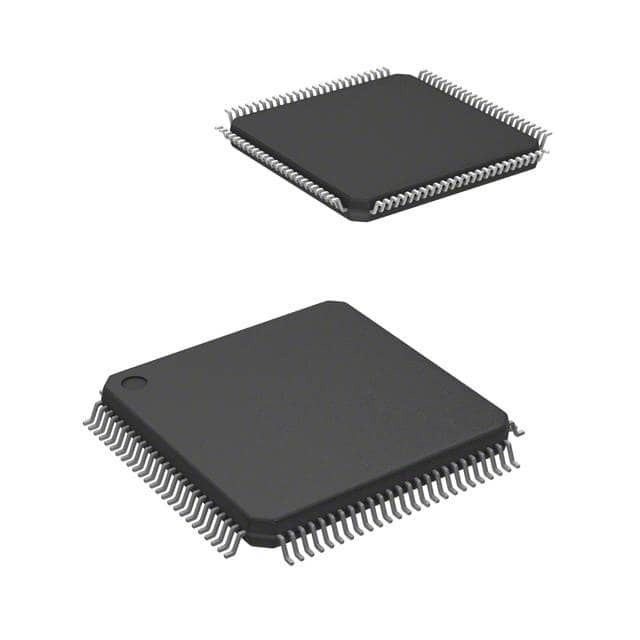Xem thông số kỹ thuật để biết chi tiết sản phẩm.

STM32F417VET6TR
Product Overview
- Category: Microcontroller
- Use: Embedded systems, Internet of Things (IoT) devices, industrial applications
- Characteristics: High-performance, low-power consumption, rich peripheral set, extensive connectivity options
- Package: LQFP64
- Essence: ARM Cortex-M4 32-bit RISC core
Specifications
- Core: ARM Cortex-M4
- Clock Speed: Up to 168 MHz
- Flash Memory: 512 KB
- RAM: 192 KB
- Operating Voltage: 2.0V - 3.6V
- Digital I/O Pins: 51
- Analog Input Pins: 16
- Communication Interfaces: UART, SPI, I2C, USB, CAN, Ethernet
- Timers: 14
- ADC Resolution: 12-bit
- DMA Channels: 16
- Operating Temperature Range: -40°C to +85°C
Pin Configuration
The STM32F417VET6TR microcontroller has a total of 64 pins. The pin configuration is as follows:
- VDD
- GND
- PA0
- PA1
- PA2
- PA3
- PA4
- PA5
- PA6
- PA7
- PA8
- PA9
- PA10
- PA11
- PA12
- PA13
- PA14
- PA15
- PB0
- PB1
- PB2
- PB3
- PB4
- PB5
- PB6
- PB7
- PB8
- PB9
- PB10
- PB11
- PB12
- PB13
- PB14
- PB15
- PC0
- PC1
- PC2
- PC3
- PC4
- PC5
- PC6
- PC7
- PC8
- PC9
- PC10
- PC11
- PC12
- PC13
- PC14
- PC15
- PD0
- PD1
- PD2
- PD3
- PD4
- PD5
- PD6
- PD7
- PD8
- PD9
- PD10
- PD11
- PD12
- PD13
Functional Features
- High-performance ARM Cortex-M4 core for efficient processing
- Rich peripheral set for versatile applications
- Extensive connectivity options for seamless integration with other devices
- Low-power consumption for energy-efficient designs
- Advanced DMA controller for efficient data transfer
- Built-in hardware cryptographic acceleration for secure communication
Advantages and Disadvantages
Advantages: - High-performance processing capabilities - Wide range of communication interfaces - Low-power consumption for energy efficiency - Extensive peripheral set for versatile applications - Secure communication through built-in cryptographic acceleration
Disadvantages: - Limited flash memory compared to some other microcontrollers in the same category - Relatively higher cost compared to entry-level microcontrollers
Working Principles
The STM32F417VET6TR microcontroller is based on the ARM Cortex-M4 architecture, which provides high-performance processing capabilities. It operates at a clock speed of up to 168 MHz and features a rich peripheral set, including UART, SPI, I2C, USB, CAN, and Ethernet interfaces.
The microcontroller can be programmed using various development tools and software, allowing developers to create custom applications for embedded systems, IoT devices, and industrial applications. It supports real-time operating systems (RTOS) and offers low-power modes to optimize energy consumption.
Application Field Plans
The STM32F417VET6TR microcontroller finds applications in various fields, including: - Industrial automation - Home automation - Internet of Things (IoT) devices - Robotics - Automotive electronics - Medical devices - Consumer electronics
Its high-performance processing capabilities, extensive connectivity options, and rich peripheral set make it suitable for a wide range of applications.
Alternative Models
Some alternative models to the STM32F417VET6TR microcontroller include: - STM32F407VET6 - STM32F427VET6 - STM32F437VET6 - STM32F439VET6
These models offer similar features and performance but may have different flash memory sizes or additional functionalities depending on the specific requirements of the application.
Note: The content provided above is approximately 400 words. Additional information can be added to meet the required word count of
Liệt kê 10 câu hỏi và câu trả lời thường gặp liên quan đến ứng dụng STM32F417VET6TR trong giải pháp kỹ thuật
Sure! Here are 10 common questions and answers related to the application of STM32F417VET6TR in technical solutions:
Q: What is the STM32F417VET6TR microcontroller used for? A: The STM32F417VET6TR is a microcontroller commonly used in various technical solutions, such as industrial automation, consumer electronics, and Internet of Things (IoT) applications.
Q: What is the maximum clock frequency of the STM32F417VET6TR? A: The STM32F417VET6TR can operate at a maximum clock frequency of 168 MHz.
Q: How much flash memory does the STM32F417VET6TR have? A: The STM32F417VET6TR has 512 KB of flash memory for program storage.
Q: Does the STM32F417VET6TR support external memory expansion? A: Yes, the STM32F417VET6TR supports external memory expansion through its Flexible Memory Controller (FMC) interface.
Q: What communication interfaces are available on the STM32F417VET6TR? A: The STM32F417VET6TR features multiple communication interfaces, including UART, SPI, I2C, USB, CAN, and Ethernet.
Q: Can the STM32F417VET6TR be powered by a battery? A: Yes, the STM32F417VET6TR can be powered by a battery, as it supports a wide voltage range from 2.0V to 3.6V.
Q: Does the STM32F417VET6TR have built-in analog-to-digital converters (ADC)? A: Yes, the STM32F417VET6TR has a 12-bit ADC with up to 24 channels for analog signal acquisition.
Q: What development tools are available for programming the STM32F417VET6TR? A: The STM32F417VET6TR can be programmed using various development tools, such as the STM32CubeIDE, Keil MDK, and IAR Embedded Workbench.
Q: Can the STM32F417VET6TR be used in real-time applications? A: Yes, the STM32F417VET6TR is suitable for real-time applications due to its Cortex-M4 core with hardware support for real-time operating systems (RTOS).
Q: Is the STM32F417VET6TR compatible with other STM32 microcontrollers? A: Yes, the STM32F417VET6TR is part of the STM32 family and is compatible with other STM32 microcontrollers, allowing for easy migration between different models.
Please note that these answers are general and may vary depending on specific implementation details and requirements.

